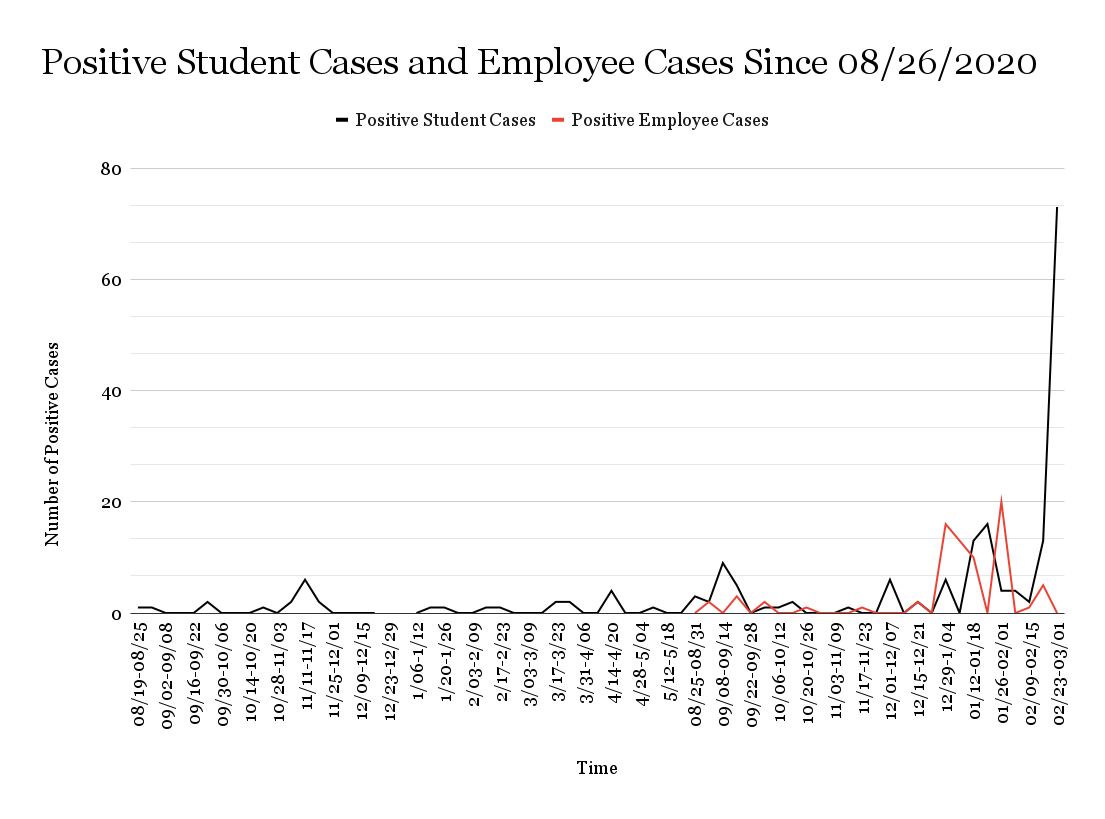By Lizzie Allen, Features Editor, and Rebecca Li, Staff Writer
With many states and major cities rescinding their mask mandates as COVID cases fall and the immediate threat of the Omicron variant having seemingly retreated, Haverford registered its highest ever active case count. This spike comes after the Bi-Co, too, recently relaxed COVID precautions. Haverford loosened COVID policies two weeks ago on February 17, allowing indoor unmasking in select circumstances — including regular capacity dining, dorms, shared work spaces, and parties — but maintaining masking requirements in classrooms and other public spaces. Bryn Mawr eased restrictions on February 24, albeit less extensively than Haverford, allowing for increased dining hall capacities and some indoor unmasking.
At Haverford, cases rose immediately after the College relaxed protocols. The week of February 16, Haverford reported 18 positive tests: 13 students and 5 employees. The subsequent week of February 23, Haverford tallied 88 positives: 87 students and 1 employee. In the span of these two weeks, approximately 7.8% of Haverford’s student enrollment tested positive. Indeed, the College ran out of quarantine rooms in the past week, instead housing infected students in local hotels.

Haverford College administration has not commented on the possible origins of the outbreak, but many have speculated that athletic team parties — permitted under the loosened guidelines — spurred the outbreak. Bryn Mawr College has also elected to not issue a statement on the Haverford outbreak. However, the Bryn Mawr Provost’s Office said the surge was “evidently a result of students gathering in small crowds with little to no masking” in a February 26 email warning faculty about the rise in cases at Haverford and its potential impact on class attendance. A number of small parties are also known to have occurred at Bryn Mawr this past weekend.
A Bryn Mawr professor confirmed that there has been no further communication since the Saturday email. Nevertheless, some faculty at both colleges have made the decision to hold class meetings virtually for the week, with Bryn Mawr faculty potentially using their limited allowance of discretionary remote teaching.
The February 26 email further emphasized that cases at Bryn Mawr appeared steady based on the data available under Bryn Mawr’s non-comprehensive testing and said “there is no evidence of Omicron transmission in our classrooms or Haverford’s (thanks to masking and vaccination).”
Student groups such DASH (Disability Advocacy for Students at Haverford) have expressed concern over the Haverford outbreak, inviting concerned students to join a Zoom call on February 25 to discuss with Dean McKnight. At Bryn Mawr, student hall advisors have sent out emails reminding others that masking is still required in Bryn Mawr dorms.
Haverford’s active cases currently appears to have gone down — there are 29 reported active cases as of publication — presumably as a factor of many students having now exited the mandatory 5 day isolation. However, the Bi-Co News is not aware of the specifics of Haverford’s current testing and reporting schedule.
Haverford’s COVID surge coincides with the CDC’s recent change in masking guidelines on February 25. The new decision to prioritize hospital capacity rather than transmission has shifted many regions from high to low or moderate risk overnight, despite no change in case count and the well-known lag in hospitalization. This counsel authorized nearly 70% of the United States to forgo indoor masking, a move that had been met with criticism by many public health experts and doctors. Many interpret dropping mask mandates as both premature and callous towards the immunocompromised, children too young to be vaccinated, and their families. The move was justified by CDC director Dr. Rochelle Walensky as giving Americans a “break” from wearing masks, which she has called the “scarlet letter of the pandemic.”
Image Credit: Haverford College, The Clerk
